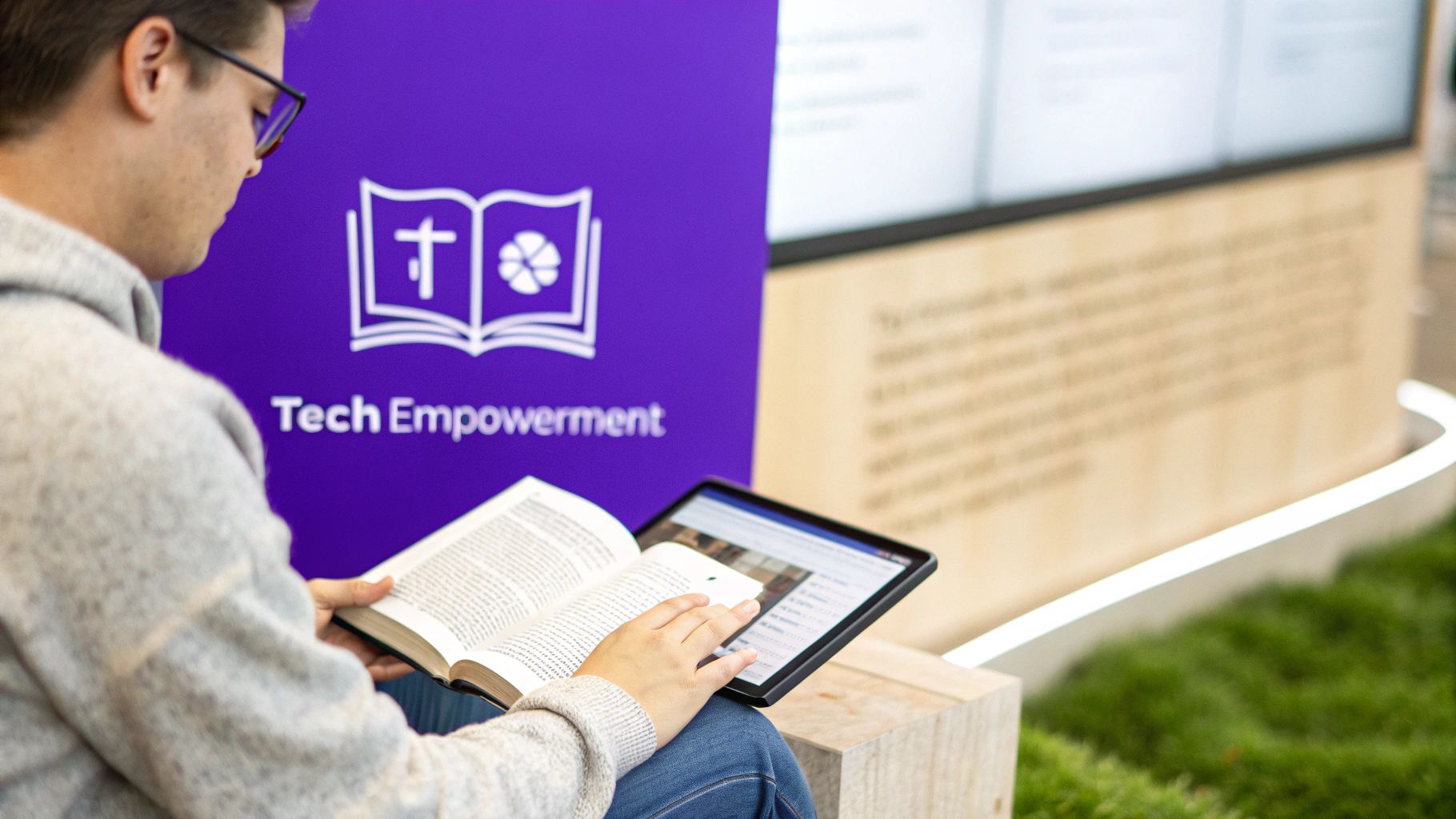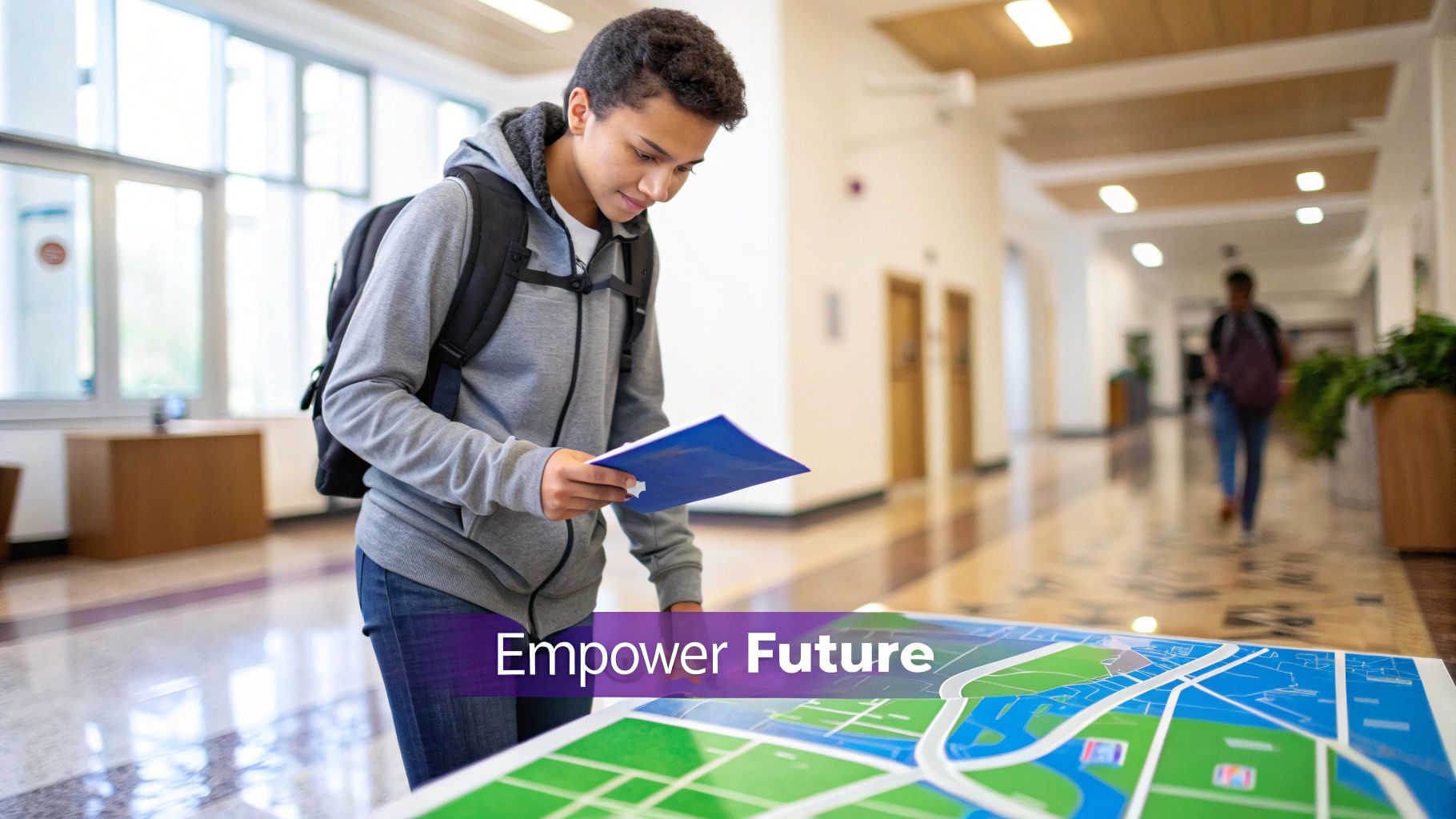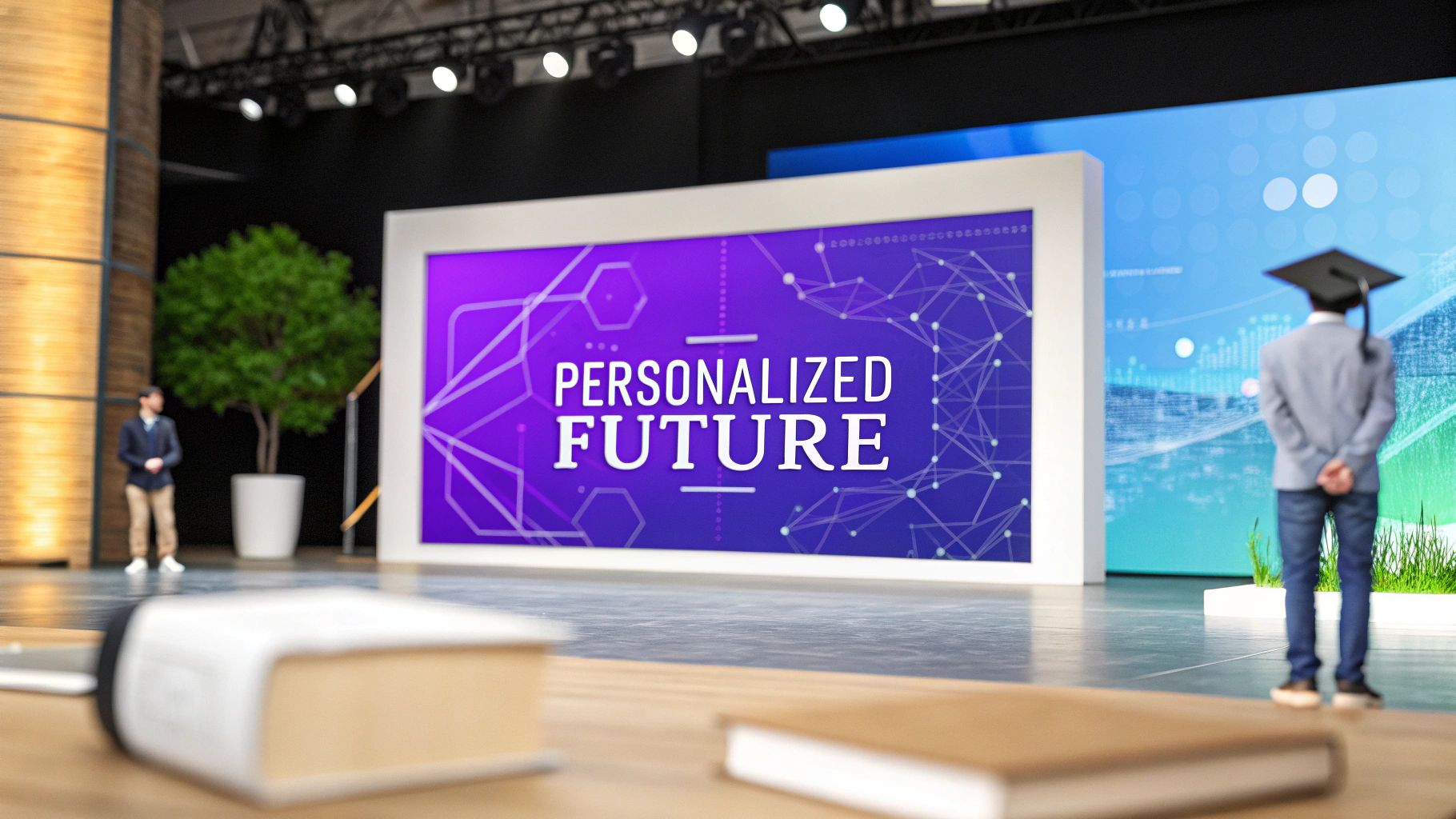The Power of Personalization: Why One-Size Education Fails
Traditional education often takes a one-size-fits-all approach. It's like trying to force square pegs into round holes. This method, while seemingly efficient, overlooks the unique needs of individual learners. Students learn at different paces, and have varied strengths and weaknesses.
This standardized environment can make it difficult for many students to truly thrive. Consequently, some learners are left behind, unable to reach their full potential. Personalized learning paths provide a much-needed alternative.
Personalized learning recognizes that students learn best when education caters to their individual needs and preferences. For instance, visual learners might benefit from diagrams and videos. Kinesthetic learners might learn best through hands-on activities.
Personalized learning also acknowledges varying learning speeds. Some students grasp concepts quickly, while others need more time and practice. This flexibility lets students progress at their own pace, avoiding frustration and unnecessary pressure.
This approach also empowers learners to take ownership of their education. When students have a voice in how they learn, their motivation and engagement increase. They become active participants, not passive recipients of information. This fosters a love of learning and a sense of accomplishment, both crucial for long-term success.
The growing demand for this customized approach is clear in market trends. The global personalized learning market, valued at USD 1.8 billion in 2023, is projected to reach USD 19.86 billion by 2030. That's a CAGR of 12.7%. This growth underscores the increasing need for educational experiences tailored to diverse learners. You can find more statistics here: Discover more insights about personalized learning
Addressing the Challenges of Traditional Education
Traditional education, with its rigid structure, struggles to adapt to the diverse needs of students. It can be compared to a factory assembly line, where everyone receives the same treatment. But students aren't identical products. They are unique individuals with diverse learning styles, paces, and motivations. Personalized learning recognizes and celebrates this diversity.
The Benefits of Personalized Learning
Personalized learning paths address the shortcomings of traditional education. They offer tailored learning experiences with several key benefits:
- Increased Engagement: Tailored content and activities keep students motivated and interested.
- Improved Performance: Students learn more effectively when instruction matches their learning style and pace.
- Greater Flexibility: Students can learn anytime, anywhere, and at their own speed.
- Enhanced Confidence: Success in personalized learning builds self-esteem and a love of learning.
These advantages create a more enriching and effective learning experience for all students.
At Tevello, we make personalized learning practical for Shopify store owners. You can create custom learning paths by setting up drip schedules, bundling courses for different segments, and gating content based on progress - all from within your Shopify admin. Whether you're teaching a skill, guiding a product experience, or running a membership site, Tevello helps you deliver the right content at the right time.
Evidence That Works: The Science of Personalized Learning

Personalized learning paths are becoming increasingly popular in education. More than just a trend, these paths are firmly rooted in research from cognitive science. This research shows how individualized instruction can greatly improve how students learn. Studies reveal a significant connection between personalized learning and better knowledge retention.
Cognitive Science and Personalized Learning
Cognitive science focuses on understanding how the brain learns best. A key finding is that each person has their own preferred ways of learning. These individual learning styles and preferences mean that a traditional, one-size-fits-all approach to teaching isn't always the most effective. Personalized learning paths address this by adjusting to each student's needs.
Personalized learning also helps students build stronger skills. When students learn in a way that suits them, they can grasp difficult ideas more easily. This focused approach allows for specific practice and feedback, resulting in improved skills.
Motivation and Agency in Learning
Motivation is essential for learning. Research consistently shows that students are more motivated when they have control over their learning. Personalized learning gives students this ownership. This sense of control can significantly increase their engagement and interest in learning.
While personalized learning focuses on individual paths, it can also include peer interaction. Adding collaborative learning techniques can enrich the learning experience. Finding the right balance between individualized learning and working together is key.
Measurable Impact: Personalized vs. Traditional
We can often measure the differences between traditional classrooms and those using personalized learning. Research shows that personalized learning can lead to better test scores and grades. For example, some schools that have adopted personalized learning have seen notable improvements in student performance, particularly in math and reading. This success stems from personalized learning's focus on addressing individual learning gaps.
To illustrate the key differences between these two approaches, let's look at the following table:
Traditional vs. Personalized Learning Approaches
This table compares key characteristics of traditional classroom instruction with personalized learning path implementation.
| Educational Aspect | Traditional Approach | Personalized Learning Approach | Impact on Student Outcomes |
|---|---|---|---|
| Pace of Learning | Set by the teacher/curriculum | Adjusted to individual student needs | Improved comprehension and mastery, reduced frustration |
| Content Delivery | Primarily lecture-based, uniform for all students | Varied resources and methods catering to different learning styles | Increased engagement and motivation, deeper understanding |
| Assessment | Standardized tests and assignments | Frequent, formative assessments and personalized feedback | More accurate measurement of progress, targeted intervention for learning gaps |
| Learning Environment | Primarily classroom-based, limited flexibility | Can include online, blended, and self-directed learning | Greater flexibility and accessibility, caters to diverse learning needs |
| Teacher's Role | Primarily instructor and knowledge dispenser | Facilitator, mentor, and personalized learning guide | Stronger student-teacher relationships, more individualized support |
The table above highlights the key distinctions between traditional and personalized approaches. The shift towards individualized instruction, flexible pacing, and varied learning resources contributes significantly to better learning outcomes and a more positive learning environment.
Furthermore, personalized learning can make students feel better about learning and improve their overall attitude towards education. This positive effect goes beyond academic performance, influencing students' general well-being and desire to learn. These results highlight personalized learning as a valuable tool for creating better educational outcomes.
Building Blocks of Success: Personalized Learning Essentials

Personalized learning paths mark a significant departure from traditional, one-size-fits-all educational models. This approach acknowledges the individuality of each student and their unique learning needs. But what are the key components that make these personalized learning experiences truly effective?
Comprehensive Learner Profiles
Building a successful personalized learning experience starts with comprehensive learner profiles. These profiles go beyond standard test scores to explore each student's individual strengths, weaknesses, learning styles, and interests. It's like creating a customized roadmap highlighting the optimal learning routes for every student.
This deep understanding allows educators to tailor instruction and resources, making learning more relevant and engaging for each individual.
Competency-Based Progression
Traditional education often focuses on seat time, simply measuring the time spent in a classroom. Personalized learning, however, frequently incorporates competency-based progression. Students progress based on demonstrated mastery of skills, not just time spent in class.
This empowers students to learn at their own pace, ensuring a thorough understanding of concepts before moving forward. This flexibility reduces frustration and fosters deeper learning. It's a more effective way to measure genuine understanding.
Flexible Learning Environments
Effective personalized learning requires flexible learning environments that seamlessly blend digital and physical experiences. Students might engage with online modules, participate in collaborative projects, or receive individualized tutoring.
This variety caters to diverse learning styles and preferences, creating a dynamic and adaptable learning ecosystem. Check out this resource on online learning platforms: How to master your online learning platforms.
Data-Informed Decisions and Student Agency
Data plays a crucial role in shaping personalized learning paths. Tracking student progress and analyzing learning patterns provide educators with valuable insights. These data-informed decisions allow them to refine instruction, suggest relevant resources, and offer targeted support.
Just as vital is student agency—giving students a voice in their educational journey. This can involve letting students choose project topics, select activities, or establish personal learning goals. When students have ownership over their learning, their motivation and engagement increase significantly. Combining data with student input creates an empowering and effective learning experience.
Real-World Impact: Nevada Connections Academy
The positive impact of personalized learning is evident in real-world applications. Schools like the Nevada Connections Academy (NCA) have implemented personalized learning paths with great success. Using adaptive tools like Core5, which addresses individual skill gaps, these programs offer tailored learning experiences.
NCA saw a significant increase in demand, reaching an enrollment cap of 3,571 students in the 2019-2020 school year and accumulating a substantial waitlist. This high demand highlights the effectiveness of personalized learning in boosting student retention and academic outcomes. For more details, see: Find more detailed statistics here. These core components, combined effectively, create a foundation for a successful and enriching personalized learning experience.
Tech That Transforms: Tools Powering Personalized Learning

Personalized learning isn't just a trend; it's a fundamental shift in how we approach education. It's about recognizing that each student learns differently and providing them with the tools and resources they need to succeed. This individualized approach relies heavily on technology, moving beyond simply digitizing traditional methods.
Adaptive Learning Systems
Adaptive learning systems are designed to act like personal tutors. These systems adjust the difficulty of the content based on a student's performance in real-time. For example, if a student struggles with fractions, the system provides extra practice and support. Conversely, if a student excels, the system introduces more challenging material, preventing boredom and encouraging continuous progress.
This dynamic approach ensures each student learns at their optimal pace, maximizing their learning potential.
The Role of AI
Artificial intelligence (AI) plays a key role in personalizing the learning experience. AI algorithms analyze learning behaviors and recommend relevant resources at the right time. This might include articles, videos, or practice exercises tailored to the student's individual needs. Think of AI as a personalized learning concierge.
This targeted approach helps students explore their interests more deeply while also providing additional support in areas where they might be struggling.
Immersive Technologies
Immersive technologies, such as virtual reality (VR) and gamification, create unique and engaging learning experiences. VR can transport students to different times and places, from ancient Rome to the depths of the ocean, making learning truly unforgettable. Gamification incorporates elements of play and competition, keeping students motivated and invested in their learning journey.
These technologies make learning more interactive, fun, and memorable.
Choosing the Right Tools
Selecting the right learning tools is crucial for successful personalized learning. Platforms like Tevello offer features like customizable learning paths and integrated communities, particularly beneficial for Shopify store owners selling digital courses alongside physical products.
Other educational platforms provide features like adaptive assessments, personalized feedback, and progress tracking. Choosing the right tools depends on your educational goals, budget, and technical capabilities. The following table offers a comparison of the technologies driving personalized learning today.
To help clarify the landscape of available solutions, the following table breaks down key technologies and their applications:
Technologies Powering Personalized Learning
This table presents various technological solutions enabling personalized learning paths, their key features, and implementation considerations.
| Technology Type | Key Features | Benefits | Implementation Considerations | Example Platforms |
|---|---|---|---|---|
| Adaptive Learning Systems | Dynamically adjusts content difficulty | Personalized pacing, improved mastery | Integration with existing LMS, data privacy | Khan Academy, Duolingo |
| AI-Powered Recommendation Engines | Suggests relevant resources | Increased engagement, deeper learning | Data analysis capabilities, algorithm transparency | Coursera, YouTube Learning |
| Immersive Technologies (VR, Gamification) | Creates engaging interactive experiences | Improved motivation, memorable learning | Cost of hardware/software, technical expertise | Google Expeditions, Minecraft: Education Edition |
| Learning Management Systems (LMS) | Tracks progress, delivers content, facilitates communication | Centralized learning hub, streamlined administration | User-friendliness, integration with other tools | Moodle, Canvas, Tevello |
By carefully evaluating these technologies and selecting the best combination for your needs, educators can create dynamic and engaging personalized learning experiences that empower students to reach their full potential. This thoughtful approach to technology integration is key to unlocking the future of learning.
From Theory to Practice: Implementing Personalized Paths
Creating personalized learning paths is a journey, not a sprint. It requires thoughtful planning and careful execution to avoid overwhelming your team and exceeding your budget. The goal is to build a sustainable system that truly benefits both educators and students.
Starting With Standards
Clear learning standards are the bedrock of any effective personalized learning program. These standards form the structure for personalization, ensuring that individual learning paths still meet the required learning objectives. Think of them as guideposts on a map – they allow for different routes but ultimately ensure everyone reaches the same destination.
Phased Implementation
A phased rollout is crucial for a smooth transition. Begin with a pilot program within a single grade level or subject area. This smaller-scale implementation allows you to refine your approach and address any unexpected hurdles before expanding the program. It also minimizes disruption and allows for ongoing improvement based on feedback from actual use.
The Evolving Role of Educators
Personalized learning shifts the role of educators from direct instruction to facilitation. Teachers become mentors and guides, providing support as students navigate their individual learning experiences. This change requires quality professional development that provides educators with the skills they need to excel in this new capacity. For educators looking to expand their skillset in online course creation, resources like How to master creating online courses can be valuable.
Reconfiguring Resources
Personalized learning often necessitates a reevaluation of traditional classroom structures. This may involve flexible scheduling, adapting learning spaces to accommodate diverse learning activities, and ensuring equitable access to both physical and digital resources. To understand how other institutions have successfully implemented personalized learning, exploring existing personalized learning strategies can be insightful. The ultimate goal is to create a dynamic learning environment that caters to individual needs and encourages collaborative learning.
Addressing Global Challenges
The shift toward personalized learning is a worldwide movement, impacting even low- and middle-income countries. Digital solutions are being developed to address the unique learning needs in these regions. However, challenges like unequal access to technology, connectivity problems, and data privacy concerns require careful attention. Local innovators play a crucial role in this process, as they are best positioned to tailor solutions to specific regional needs. This localized approach fosters more inclusive and effective personalized learning environments. To delve deeper into this topic, trends in digital personalized learning offer further insights.
Practical Implementation Strategies
Bringing personalized learning to life requires practical strategies. For example, educators can utilize regular check-ins with students to monitor progress and adapt learning paths as needed. Technology platforms with built-in personalized learning features can simplify this process. Platforms like Tevello can be particularly helpful, integrating courses and communities directly within a Shopify store for a seamless learning experience.
Open communication among teachers, students, and parents is also essential. This shared understanding ensures everyone is invested in the personalized learning journey and can contribute to its success. By implementing these practical steps, personalized learning can transition from a theoretical concept to a tangible, positive impact on student learning.
Navigating Obstacles: Making Personalized Learning Work
Personalized learning paths offer exciting possibilities for improving education. However, putting this personalized approach into practice presents unique challenges. This section explores common hurdles educators face when implementing personalized learning and offers practical solutions for diverse learning environments.
Ensuring Equity in Personalized Learning
One key concern is equity. How can we guarantee that every student has equal access to the technology and resources essential for personalized learning? Strategies include providing devices and internet access to students lacking them, offering alternative learning materials catering to different learning styles, and designing adaptable learning spaces that accommodate diverse needs. This ensures personalized learning benefits all students, not just those with readily available resources.
Balancing Personalization With Curriculum Standards
Another challenge is balancing personalized learning experiences with mandated curriculum standards and assessments. How can students meet learning objectives while pursuing individual learning paths? One solution is adopting a competency-based progression system. This allows students to advance based on demonstrated mastery, regardless of their learning path. This approach balances flexibility with standardized learning goals.
Managing Increased Complexity for Educators
Implementing personalized learning can increase complexity for educators. How can we support teachers during this transition? Robust professional development focused on personalized learning strategies and technology tools is essential. Resources like How to master online course delivery challenges can be valuable. Furthermore, streamlining workflows and promoting collaboration among teachers can alleviate the burden and create a supportive environment.
Gaining Stakeholder Buy-In
Securing buy-in from stakeholders, including parents, administrators, and the community, is crucial for long-term success. Clearly communicating the benefits of personalized learning and showcasing its measurable impact on student outcomes is key to building support and a shared vision. Regularly sharing progress updates and addressing concerns transparently fosters trust and encourages continued investment.
Addressing Ethical Considerations
As with any educational approach, ethical concerns about personalized learning require careful attention. Issues like data privacy, algorithmic bias, and equitable technology access must be addressed openly and proactively. Ongoing dialogue and evaluation are necessary to navigate these ethical complexities responsibly.
Building a Sustainable System
A successful personalized learning program requires continuous evaluation and adaptation. Regularly gathering data on student progress, teacher feedback, and stakeholder perceptions helps inform improvements and ensures long-term sustainability. This iterative process allows personalized learning to evolve and meet the changing needs of students and educators.
Ready to create a thriving learning and community hub for your Shopify store? Tevello integrates courses and communities directly into your eCommerce platform, enabling personalized learning paths, interactive workshops, and subscription modules. Start building a more engaging and profitable learning experience today.




